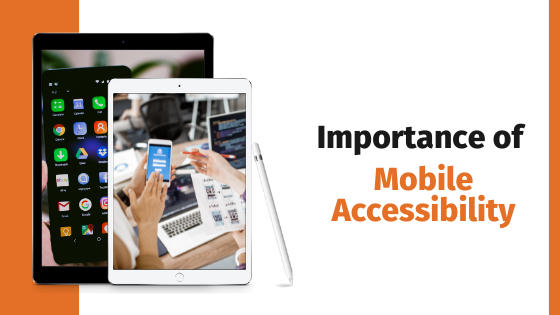Mobile accessibility or accessibility of mobile apps describes the importance of developing mobile applications for smartphones, tablets and wearables that are user-friendly for the one billion people with disabilities. According to the Web Accessibility Initiative (WAI), this means that your mobile application should be accessible to users with disabilities.
Did you know?
According to a survey, 70% of visually impaired people who use a screen reader use it on a mobile device with a view to Internet accessibility.
If you design a mobile app that will have more accessibility such as voice recognition and custom view controls, you will be able to reach a larger audience.
Web Content Accessibility Guidelines provide comprehensive best practices for developing and maintaining accessible websites and applications for desktop and mobile users. The latest WCAG guidelines, known as WCAG 2.1, set modern standards for barrier-free mobile technology with the aim of exceeding current legal requirements and achieving improved accessibility for users of mobile devices.
BarrierBreak believes that making any website or application accessible on mobile devices is equally important as making them accessible on desktops. We provide a very cost effective mobile accessibility testing service and follow a considerate approach towards ensuring accessibility of your mobile applications.
What is Mobile Accessibility?
Accessibility is the design of mobile apps for people with disabilities. The Web Accessibility Initiative of the World Wide Web Consortium (W3C) has developed a series of best mobile practices to eliminate all kinds of barriers for disabled users.
According to the W3C Web Accessibility Initiative, mobile accessibility refers to making applications accessible to people with disabilities when using mobile devices. Various guidelines from operating system giants such as iOS and Android as well as the World Wide Web Commission (W3C) integrate accessibility into the design of mobile apps. Mobile site and native app testing methods are also available through Creative Commons funds, which can be used in conjunction with WCAG to ensure that websites and apps are accessible for people with disabilities when using mobile and tablet devices.
The Merit of Mobile Accessibility
One of the best things about advancing mobile applications and smartphones is enabling people with disabilities to access the mobile world. The transition to accessible mobile technologies is essential to continue our progress towards a fairer society that does not exclude people with disabilities and handicaps from the benefits of digital tools and services. When we talk about accessibility in the mobile environment, it means that websites and apps for handheld devices can be used by people with disabilities.
As the mobile accessibility expert Paul J. Adam wrote in Part 2 of the Mobile Applications and Litigation series, it is easy and frequent to develop mobile websites and applications that work well but have features that prevent disabled users from viewing, using and navigating the mobile app or website.
This shows why it is so important to implement accessibility in the development of mobile apps. To ensure that your application is accessible, your design and development team must avoid common application development practices that prevent users with disabilities from accessing and using your app or encoding your mobile website or application. Designing and developing barrier-free mobile apps is an indispensable part of any company’s mobile app development, given that it is best practice to have bonus features.
The Conundrum
When creating or purchasing mobile apps, many institutions overlook the importance of mobile accessibility. One reason many organizations are slow to adopt new standards to help disabled users of mobile devices is that their websites and apps are not yet compatible with the digital accessibility of their mobile experience. The slow progression in mobile accessibility is due to the fact that many developers and product teams do not realize how much of the former is applicable to people with disabilities.
Web Content Accessibility Guidelines (WCAGs) apply to mobile websites and native apps, but they were developed before mobile phones were as ubiquitous as they are today. WCAGs do not cover all aspects of mobile accessibility, and conformance with WCAG2 or WCAG 2.1 will not provide users with disabilities with an accessible experience.
Conclusion
Our team of accessibility testers offer solutions that follow the principles of accessibility testing and promote the importance of mobile accessibility testing to achieve barrier-free products. It is crucial for your business to enhance its Web presence, including mobile apps and strong social media profiles but we will use mobile accessibility to talk about your business’s access to reliable mobile services and how you can deliver for your customers.
When companies bring applications to market, they should consider mobile accessibility testing as an important factor in a world where the population is aging, and older adults are at greater risk of disability.
Get in touch with BarrierBreak, to know why accessibility testing is important and how we can support you with mobile accessibility testing.
